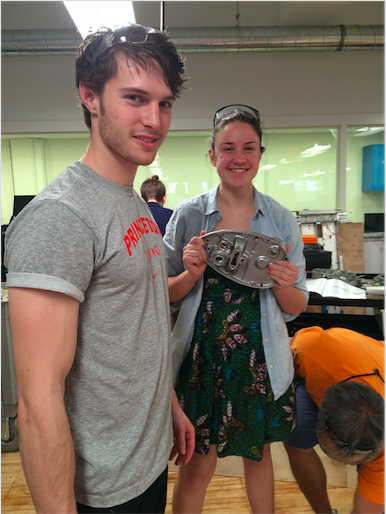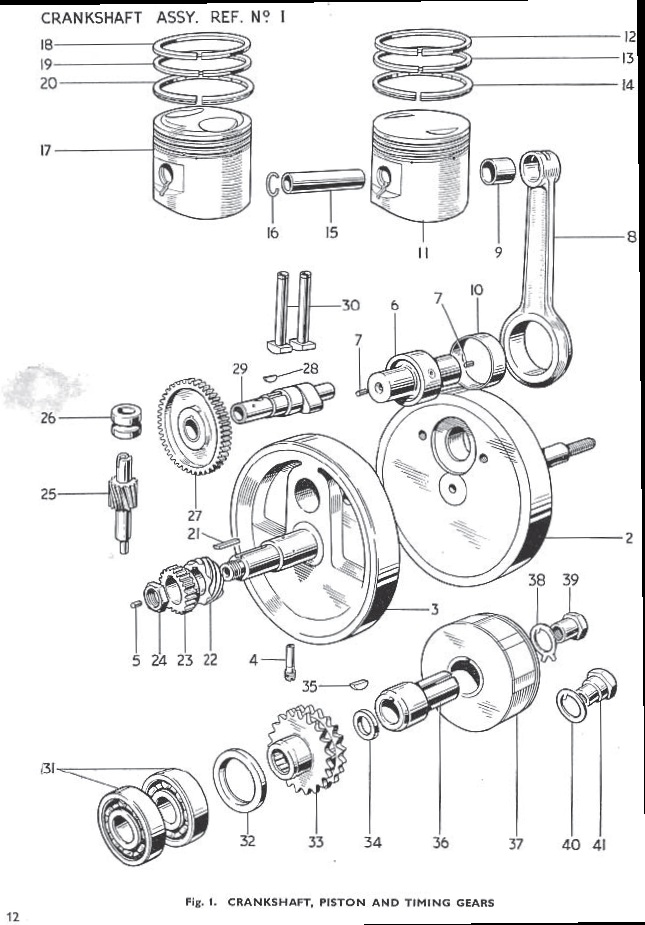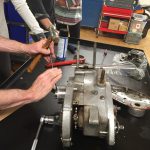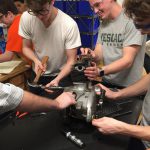Bottom End and Oil System (pump, reservoir, gallery, sump)
Jamie and Oscar

Our Journey
We have had a great time reconstructing the bottom end and oil system of the Tiger Cub! We started out by draining all of the oil out of the bike. Then, with the help of the top end and clutch folks, we took the bottom end off of the bike. Then we began disassembling: we used and learned all about Allen keys, Whitworth versus non-Whitworth wrenches, impact screwdrivers, and more. Throughout the process, we made a special effort to sort and label parts effectively, which paid off in the long run when it came to reassembling the bike. There were a couple of challenging moments – some bolts and the rotor were tough to get off. We tried many methods to get them off and it was through this process of trial and error that we were able to reach a final solution. Strategies included using a piece of wood to immobilize the connecting rod and reattaching the head of the engine, using a strap wrench, and using a chuck that we took from the lathe to hold everything still. It was great problem-solving practice! We did it in the end and finally we were able to split the case.
From there, we spent lots of time cleaning. We cleaned and re-bagged every part we had taken off of the engine and made sure they were still in good condition. We also meticulously cleaned the crankcase, making sure all of the dirt was scraped off and all of the threads were clean and we prepared the oil tank to be powder coated. We also worked with Glen to realign the flywheel using a hammer – funnily the most technical part of the whole process.
In addition, we took a day off from working on the bottom end to put together the motorcycle lift! It was a great opportunity to put our skills (direction-following, handling nuts and bolts, problem-solving) to use in a new way. 
We spent some time taking apart and reassembling the ‘62. It was great reinforcement to remember the process of taking apart the bottom end / oil system and exciting to see how much more quickly it went as we knew what to do when we encountered problems we had seen before! It was also great practice for the ‘65: once everything was clean and we had decided which parts were not fit to reuse and we had replaced them, we began the process of putting the ’65 back together. This involved fitting the oil pump, buttoning up the case, applying liquid gasket, working together with the clutch, top end, and gaskets teams in this process to make the engine work again. Eventually, the entire bike came together thanks to everyone’s hard work. Hearing the engine start and realizing that we played a big role in making that happen was truly rewarding moment as we could see (and hear) the results of our hard work all semester.
We have gained so much from this class – not only do we have a great understanding of how motorcycles work (we never would have believed six months ago that we would know this much about motorcycles!) and a handle on some essential technical and mechanical skills, but we have also learned a lot about communication, teamwork, problem-solving, and persistence. As we saw with the lift which we built in class, we are prepared and able to apply the lessons we learnt in this class to problems that we could well encounter on a day to day basis. Thank you all: Professor Littman, Glen, John, Al, and Noel for all of your guidance and support and to everyone at Princeton who has made this class possible! Also, thank you to our whole class – putting together this bike was a team effort and we loved working with and getting to know all of you!
With much gratitude,
Oscar and Jamie

Key Terms
Dry Sump: A lubricating motor oil management method, which keeps the oil reservoir external from the engine.
Oil Pump: In a dry sump system this is made of two parts: the feed and the scavenge. The feed draws oil from the main reservoir and feeds it to the engine. The scavenge draws the oil from the bottom of the engine and returns it to the reservoir (oil tank).
Oil Tank: The external oil reservoir, where most of the oil is at any one time.
SAE: Society of Automotive Engineers (SAE) defines a numerical system for grading motor oils according to viscosity. Our bike uses at both 20 SAE and 30 SAE oil.
Crankcase: The metal case that contains the crankshaft. Our motorcycle had a two-piece crankcase which was held together by liquid gasket.
Crankshaft: Made up of the flywheel (3) and the connecting rod (8). The flywheel is a metal wheel made of two halves which converts the vertical motion of the piston into rotary motion. It rotates 180 degrees for every stroke. The connecting rod is between the two halves of the flywheel and transfers force from the piston to the flywheel to make it move.
Camshaft (29): Connected to the crankshaft, helps to open the valves which make the strokes possible.


